Evaluation on Material Anisotropy of Acrylonitrile Butadiene Styrene Printed via Fused Deposition Modelling
Abstract
1. Introduction
2. Materials and Methods
2.1. Material Selection and Filament Preparation
2.2. Coupon Design and Testing
2.3. Characterisation Methods
2.4. Numerical Modelling and Simulations
3. Results and Discussion
3.1. Experimental
3.1.1. Characterisation of the Extruded ABS Filaments
3.1.2. The Effect of Layer Thickness on Anisotropy
3.1.3. The Effects of Raster Angle on Anisotropy
3.1.4. The Effects of Infill Percentage on Anisotropy
3.1.5. The Effect of Nozzle Temperature Variation on Anisotropy
3.2. Comparisons of Experimental and Numerical Results
3.3. Extension to the MROM Modelling Investigation for Samples Printed in TBO
4. Conclusions
- Although the best mechanical properties for the ABS polymer in the LBO and TBO were recorded at the 0.25 mm and 0.15 mm layer thicknesses, respectively, the minimum mechanical anisotropy for this polymer was recorded at 0.15 mm.
- In terms of raster angle, samples made of ABS and printed with a 0°/90° raster angle showed the best results with lower mechanical anisotropy values compared to the +45°/−45° raster angle.
- The infill percentage can enormously influence the integrity of the structure of the FDM-printed parts and consequently the degree of mechanical anisotropy. By increasing the infill percentage, ABS showed an improving trend in mechanical properties, as well as a lower degree of mechanical anisotropy to a point that at 100% infill, the values of mechanical anisotropy reached a very similar value.
- The layer adhesion and mechanical integrity of the FDM-printed parts are very sensitive to print temperature changes and if the proper temperature can be selected, the mechanical anisotropy can be reduced noticeably. For both the LBO and TBO, 260 °C was found to be the best temperature to print samples.
- The UTS of the samples printed in the LBO can be predicted using the ROM method with very accurate results. By contrast, the UTS of those samples printed in the TBO only can be predicted by introducing additional functions with the modified ROM with an increase of 10% in accuracy.
- It is worth mentioning that the developed MROM provides an effective tool to predict the material proprieties of FDM-printed ABS compared to the original ROM validated by experimental data.
Author Contributions
Funding
Institutional Review Board Statement
Informed Consent Statement
Data Availability Statement
Acknowledgments
Conflicts of Interest
References
- Freitas, D.; Almeida, H.A.; Bártolo, H.; Bártolo, P.J. Sustainability in extrusion-based additive manufacturing technologies. Prog. Addit. Manuf. 2016, 1, 65–78. [Google Scholar] [CrossRef]
- Campana, G.; Mele, M.; Ciotti, M.; Rocchi, A. Environmental impacts of self-replicating three-dimensional printers. Sustain. Mater. Technol. 2021, 30, e00335. [Google Scholar] [CrossRef]
- Feng, X.; Yang, Z.; Rostom, S.S.H.; Dadmun, M.; Xie, Y.; Wang, S. Structural, mechanical, and thermal properties of 3D printed L-CNC/acrylonitrile butadiene styrene nanocomposites. J. Appl. Polym. Sci. 2017, 134, 45082. [Google Scholar] [CrossRef]
- Syrlybayev, D.; Zharylkassyn, B.; Seisekulova, A.; Akhmetov, M.; Perveen, A.; Talamona, D. Optimisation of Strength Properties of FDM Printed Parts—A Critical Review. Polymers 2021, 13, 1587. [Google Scholar] [CrossRef]
- Ngo, T.D.; Kashani, A.; Imbalzano, G.; Nguyen, K.T.Q.; Hui, D. Additive manufacturing (3D printing): A review of materials, methods, applications and challenges. Compos. Part B Eng. 2018, 143, 172–196. [Google Scholar] [CrossRef]
- Hull, C.W. Apparatus for Production of Three-Dimensional Objects by Stereolithography. U.S. Patent US4575330A, 19 December 1989. Available online: https://patents.google.com/patent/US4575330A/en (accessed on 20 February 2024).
- Campbell, T.A.; Ivanova, O.S. 3D printing of multifunctional nanocomposites. Nano Today 2013, 8, 119–120. [Google Scholar] [CrossRef]
- de Leon, A.C.; Chen, Q.; Palaganas, N.B.; Palaganas, J.O.; Manapat, J.; Advincula, R.C. High performance polymer nanocomposites for additive manufacturing applications. React. Funct. Polym. 2016, 103, 141–155. [Google Scholar] [CrossRef]
- Zohdi, N.; Yang, R. Material Anisotropy in Additively Manufactured Polymers and Polymer Composites: A Review. Polymers 2021, 13, 3368. [Google Scholar] [CrossRef] [PubMed]
- Saroia, J.; Wang, Y.; Wei, Q.; Lei, M.; Li, X.; Guo, Y.; Zhang, K. A review on 3D printed matrix polymer composites: Its potential and future challenges. Int. J. Adv. Manuf. Technol. 2020, 106, 1695–1721. [Google Scholar] [CrossRef]
- Wang, P.; Zou, B.; Ding, S.; Li, L.; Huang, C. Effects of FDM-3D printing parameters on mechanical properties and microstructure of CF/PEEK and GF/PEEK. Chin. J. Aeronaut. 2021, 34, 236–246. [Google Scholar] [CrossRef]
- Gooch, J.W. Encyclopedic Dictionary of Polymers; Springer: New York, NY, USA, 2011; Available online: https://www.amazon.com.au/Encyclopedic-Dictionary-Polymers-Jan-Gooch/dp/0387310215 (accessed on 20 February 2024).
- Sathish Kumar, K.; Soundararajan, R.; Shanthosh, G.; Saravanakumar, P.; Ratteesh, M. Augmenting effect of infill density and annealing on mechanical properties of PETG and CFPETG composites fabricated by FDM. Mater. Today Proc. 2021, 45, 2186–2191. [Google Scholar] [CrossRef]
- Gordeev, E.G.; Galushko, A.S.; Ananikov, V.P. Improvement of quality of 3D printed objects by elimination of microscopic structural defects in fused deposition modeling. PLoS ONE 2018, 13, e0198370. [Google Scholar] [CrossRef]
- De Bernardez, L.; Campana, G.; Mele, M.; Mur, S. Towards a Comparative Index Assessing Mechanical Performance, Material Consumption and Energy Requirements for Additive Manufactured Parts; Springer International Publishing: Berlin/Heidelberg, Germany, 2023; pp. 302–310. [Google Scholar]
- Croccolo, D.; De Agostinis, M.; Fini, S.; Mele, M.; Olmi, G.; Campana, G. Effects of infill temperature on the tensile properties and warping of 3D-printed polylactic acid. Prog. Addit. Manuf. 2023. [Google Scholar] [CrossRef]
- De Bernardez, L.; Campana, G.; Mele, M.; Sanguineti, J.; Sandre, C.; Mur, S.M. Effects of infill patterns on part performances and energy consumption in acrylonitrile butadiene styrene fused filament fabrication via industrial-grade machine. Prog. Addit. Manuf. 2023, 8, 117–129. [Google Scholar] [CrossRef]
- Samykano, M.; Selvamani, S.K.; Kadirgama, K.; Ngui, W.K.; Kanagaraj, G.; Sudhakar, K. Mechanical property of FDM printed ABS: Influence of printing parameters. Int. J. Adv. Manuf. Technol. 2019, 102, 2779–2796. [Google Scholar] [CrossRef]
- Deshwal, S.; Kumar, A.; Chhabra, D. Exercising hybrid statistical tools GA-RSM, GA-ANN and GA-ANFIS to optimize FDM process parameters for tensile strength improvement. CIRP J. Manuf. Sci. Technol. 2020, 31, 189–199. [Google Scholar] [CrossRef]
- Wang, S.; Ma, Y.; Deng, Z.; Zhang, S.; Cai, J. Effects of fused deposition modeling process parameters on tensile, dynamic mechanical properties of 3D printed polylactic acid materials. Polym. Test. 2020, 86, 106483. [Google Scholar] [CrossRef]
- Trzepieciński, T.; Ryzińska, G.; Biglar, M.; Gromada, M. Modelling of multilayer actuator layers by homogenisation technique using Digimat software. Ceram. Int. 2017, 43, 3259–3266. [Google Scholar] [CrossRef]
- Deng, K.; Khakpour, H.; Meneguzzo Pasquali, F.; Amaria, A.; Armstrong, J.; Hall, J. Rule of Mixtures Model to Determine Elastic Modulus and Tensile Strength of 3D Printed Carbon Fiber Reinforced Nylon; 2019. Available online: https://asmedigitalcollection.asme.org/IDETC-CIE/proceedings-abstract/IDETC-CIE2019/59186/V02AT03A039/1069759 (accessed on 20 February 2024).
- Luo, Z.; Li, X.; Shang, J.; Zhu, H.; Fang, D. Modified rule of mixtures and Halpin–Tsai model for prediction of tensile strength of micron-sized reinforced composites and Young’s modulus of multiscale reinforced composites for direct extrusion fabrication. Adv. Mech. Eng. 2018, 10, 1687814018785286. [Google Scholar] [CrossRef]
- Nguyen, P.Q.K.; Zohdi, N.; Kamlade, P.; Yang, R. Predicting Material Properties of Additively Manufactured Acrylonitrile Butadiene Styrene via a Multiscale Analysis Process. Polymers 2022, 14, 4310. [Google Scholar] [CrossRef] [PubMed]
- Goh, G.D.; Yap, Y.L.; Tan, H.K.J.; Sing, S.L.; Goh, G.L.; Yeong, W.Y. Process–Structure–Properties in Polymer Additive Manufacturing via Material Extrusion: A Review. Crit. Rev. Solid State Mater. Sci. 2020, 45, 113–133. [Google Scholar] [CrossRef]
- Gao, X.; Qi, S.; Kuang, X.; Su, Y.; Li, J.; Wang, D.J.A.M. Fused filament fabrication of polymer materials: A review of interlayer bond. Addit. Manuf. 2020, 37, 101658. [Google Scholar] [CrossRef]
- Baker, A.M.; Mccoy, J.; Majumdar, B.S.; Rumley-Ouellette, B.; Wahry, J.; Marchi, A.N.; Bernardin, J.D.; Spernjak, D. Measurement and Modelling of Thermal and Mechanical Anisotropy of Parts Additively Manufactured using Fused Deposition Modelling (FDM). In Proceedings of the 11th International Workshop on Structural Health Monitoring 2017, Stanford, CA, USA, 12–14 September 2017. [Google Scholar]
- Zohdi, N.; Tareq, S.; Yang, C. Investigation on mechanical anisotropy of high impact polystyrene fabricated via fused deposition modelling. In Proceedings of the International Conference on Mechanical and Manufacturing Engineering Research and Practice, Sydney, Australia, 24–28 November 2019; pp. 24–28. [Google Scholar]
- Kam, M.; İpekçi, A.; Şengül, Ö. Investigation of the effect of FDM process parameters on mechanical properties of 3D printed PA12 samples using Taguchi method. J. Thermoplast. Compos. Mater. 2021, 36, 89270572110064. [Google Scholar] [CrossRef]
- Dev, S.; Srivastava, R. Influence of process variables on mechanical properties and material weight of acrylic butadiene styrene parts produced by fused filament fabrication. Prog. Addit. Manuf. 2022, 8, 143–158. [Google Scholar] [CrossRef]
- Bakır, A.A.; Atik, R.; Özerinç, S. Effect of fused deposition modeling process parameters on the mechanical properties of recycled polyethylene terephthalate parts. J. Appl. Polym. Sci. 2021, 138, 49709. [Google Scholar] [CrossRef]
- Tura, A.D.; Lemu, H.G.; Mamo, H.B.; Santhosh, A.J. Prediction of tensile strength in fused deposition modeling process using artificial neural network and fuzzy logic. Prog. Addit. Manuf. 2022, 8, 529–539. [Google Scholar] [CrossRef]




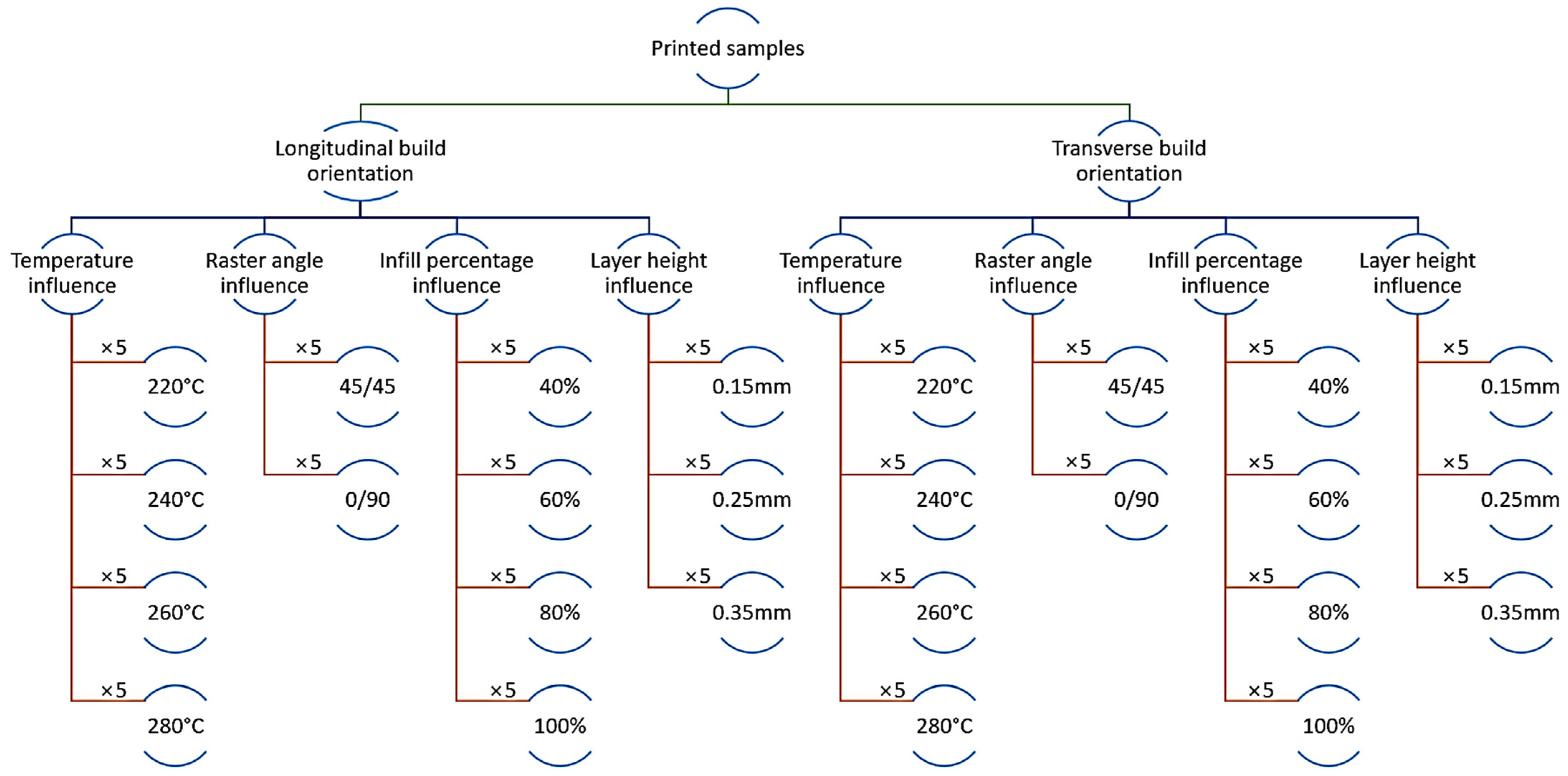
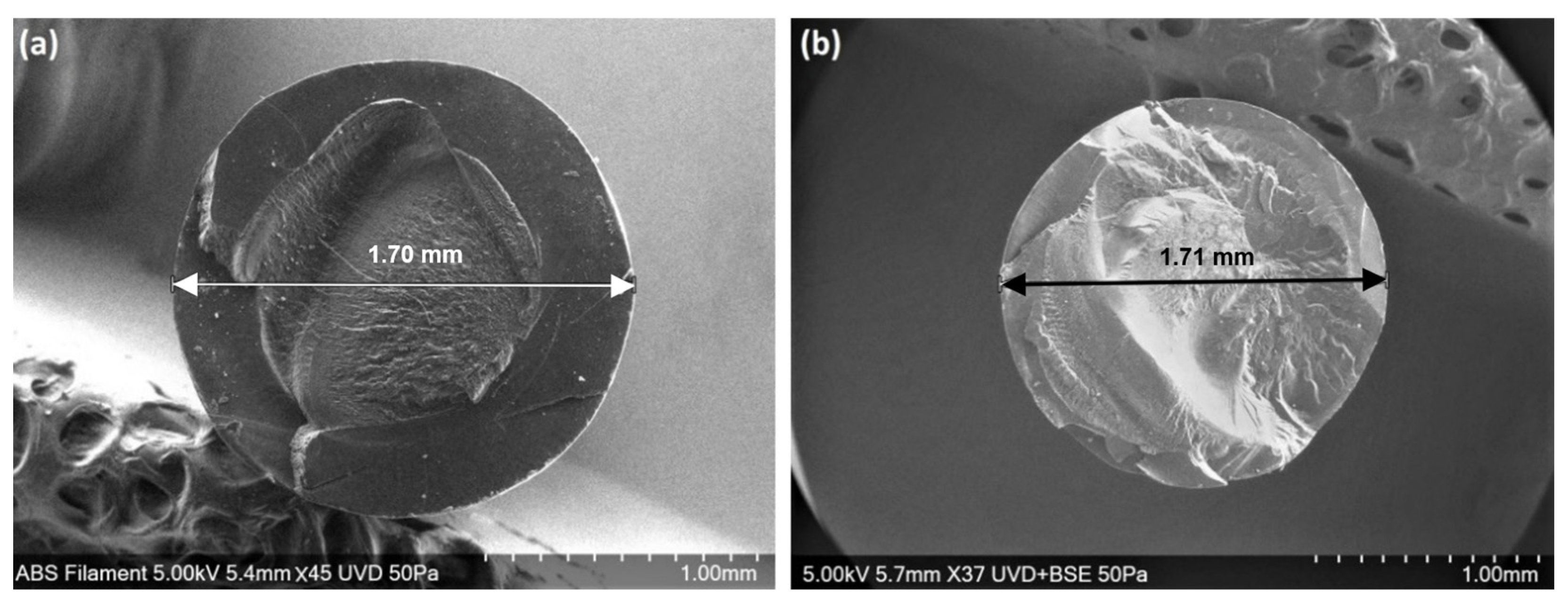
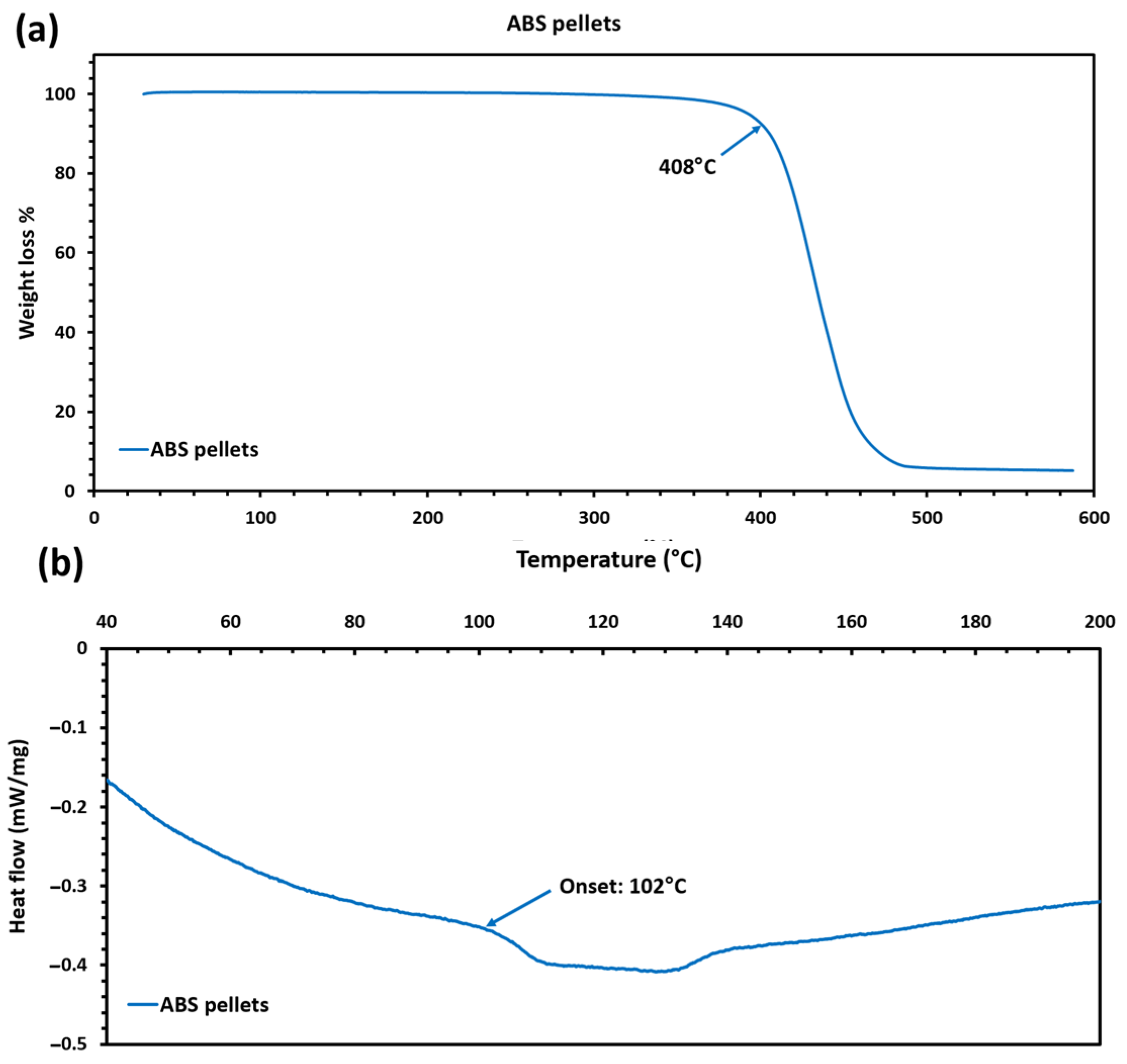


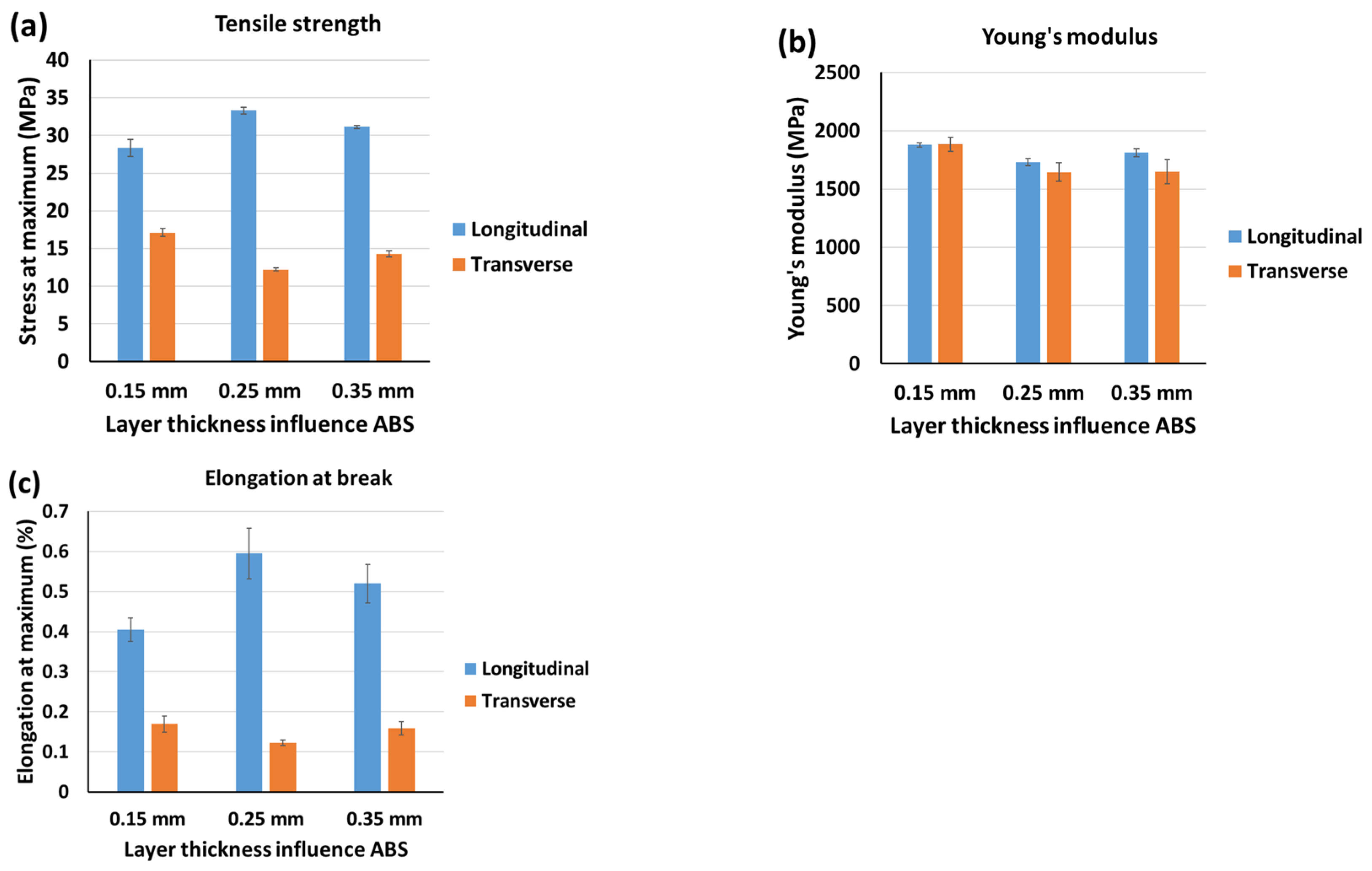



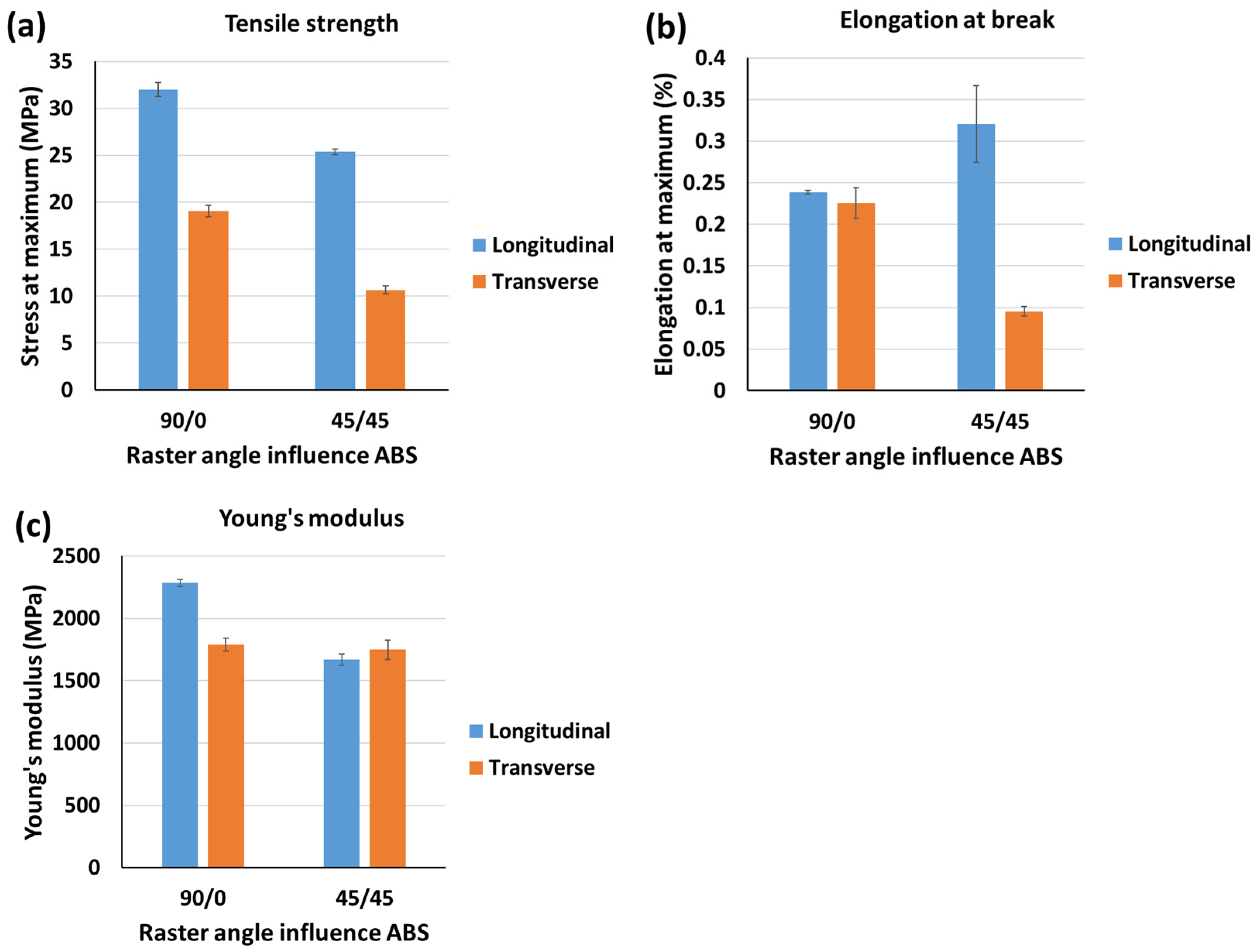
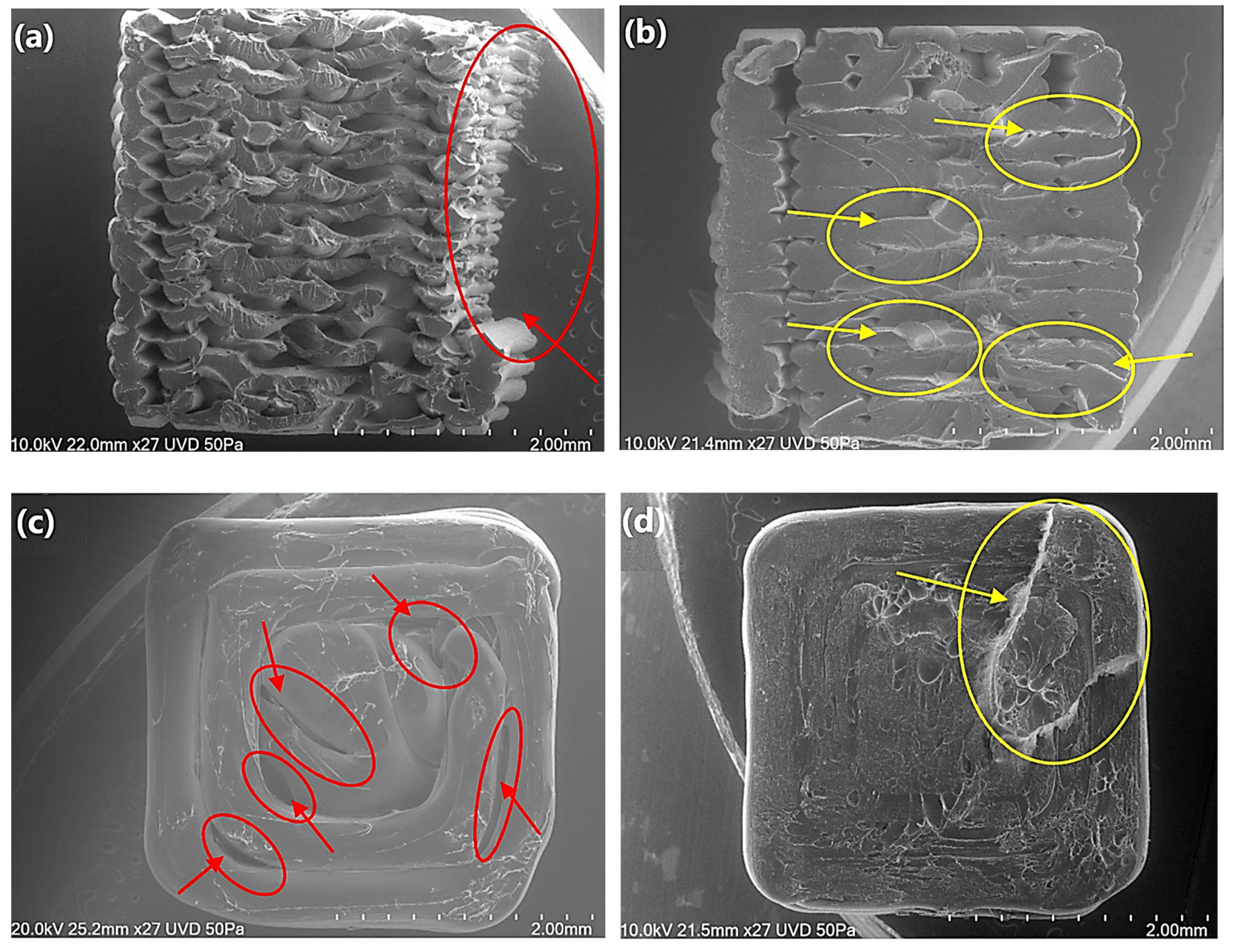
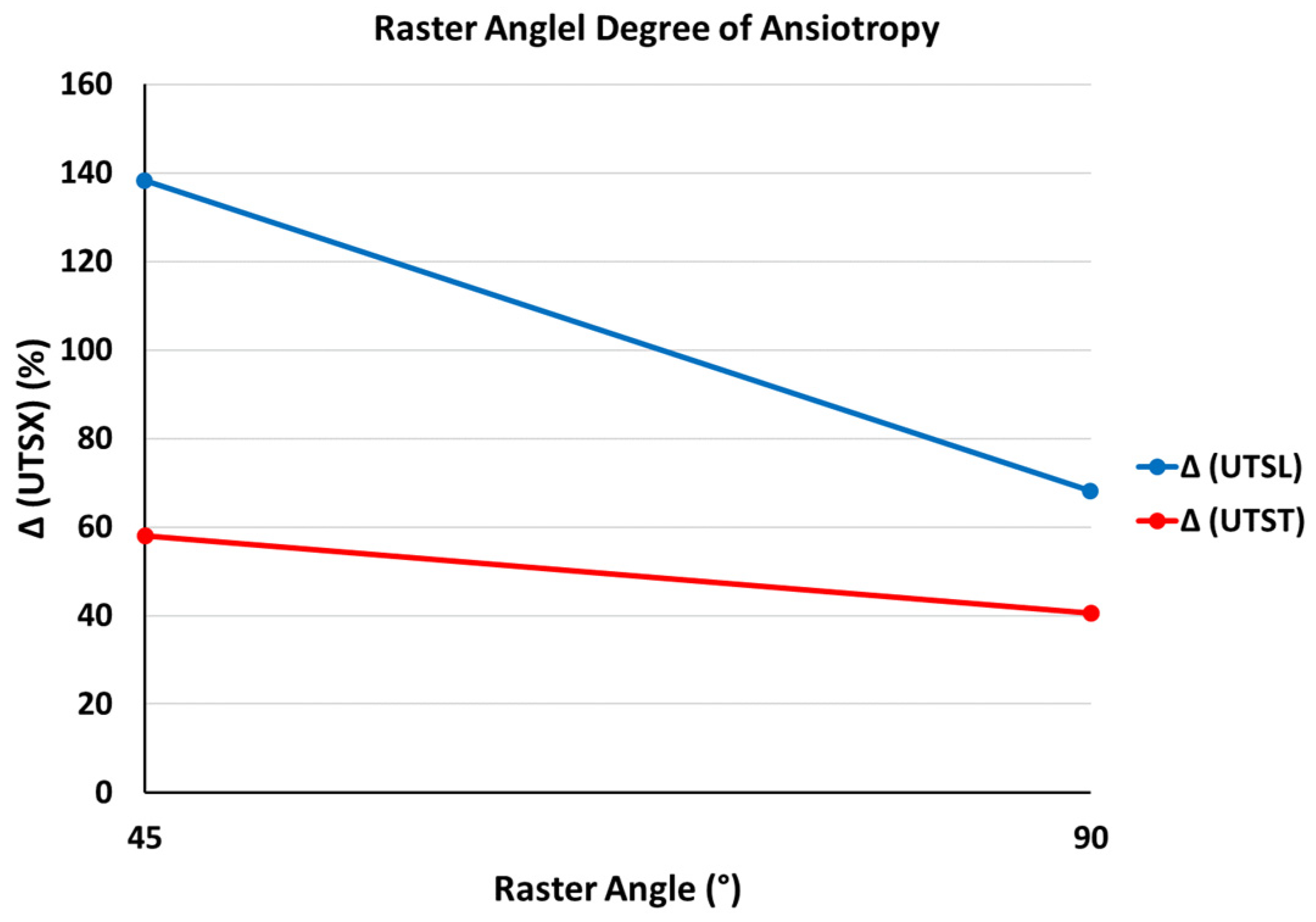

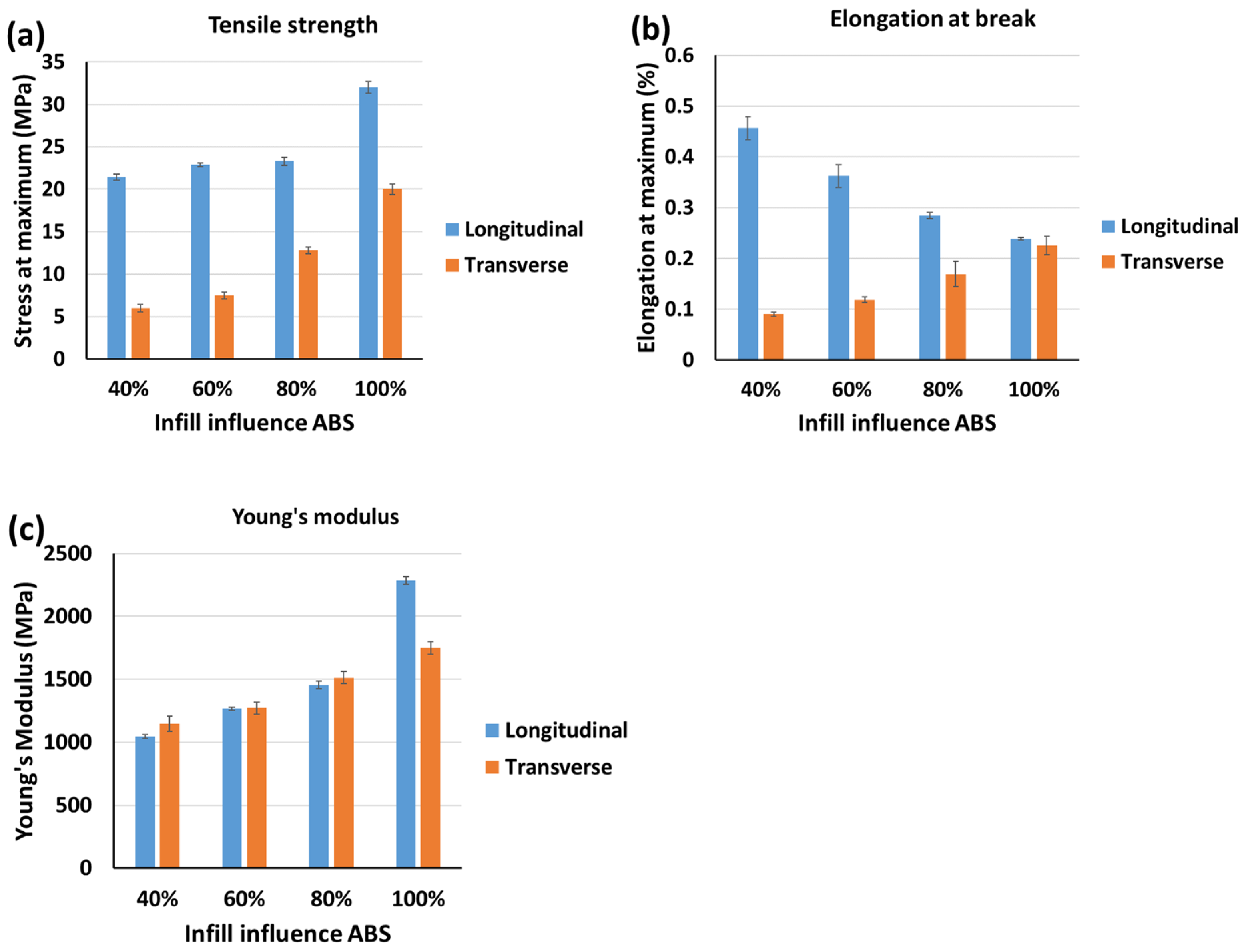
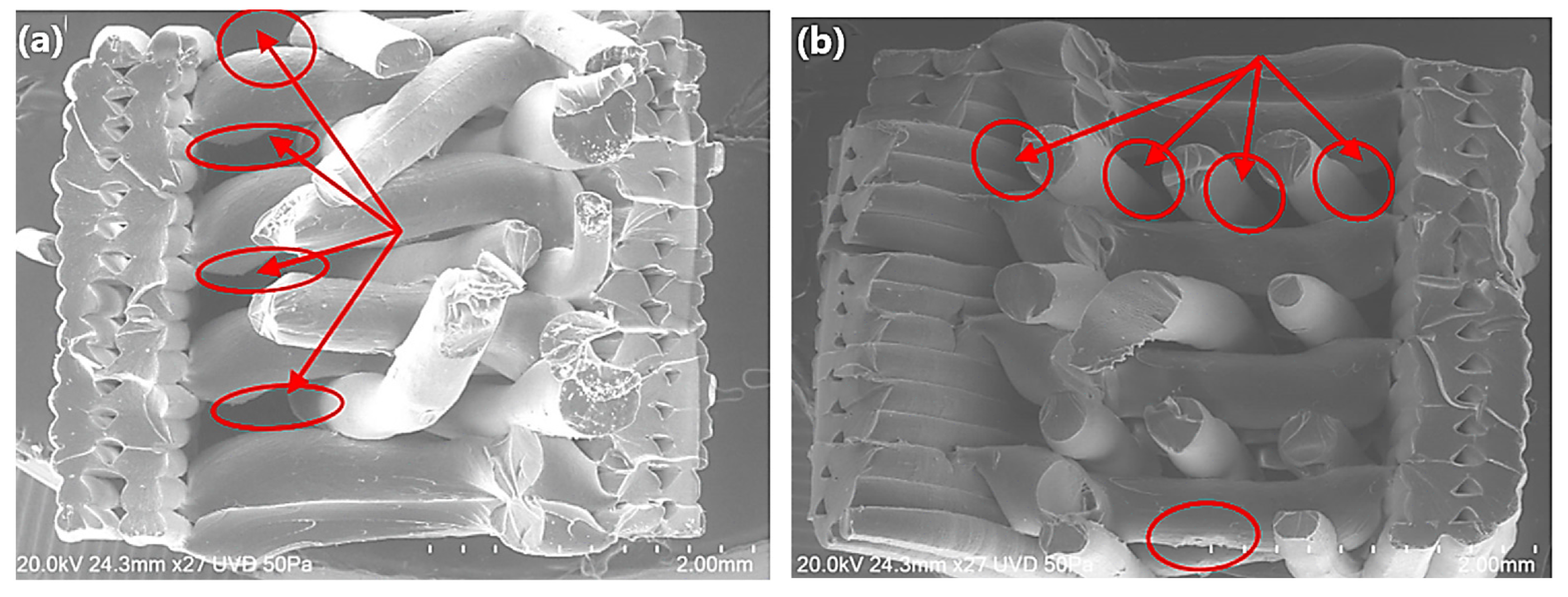
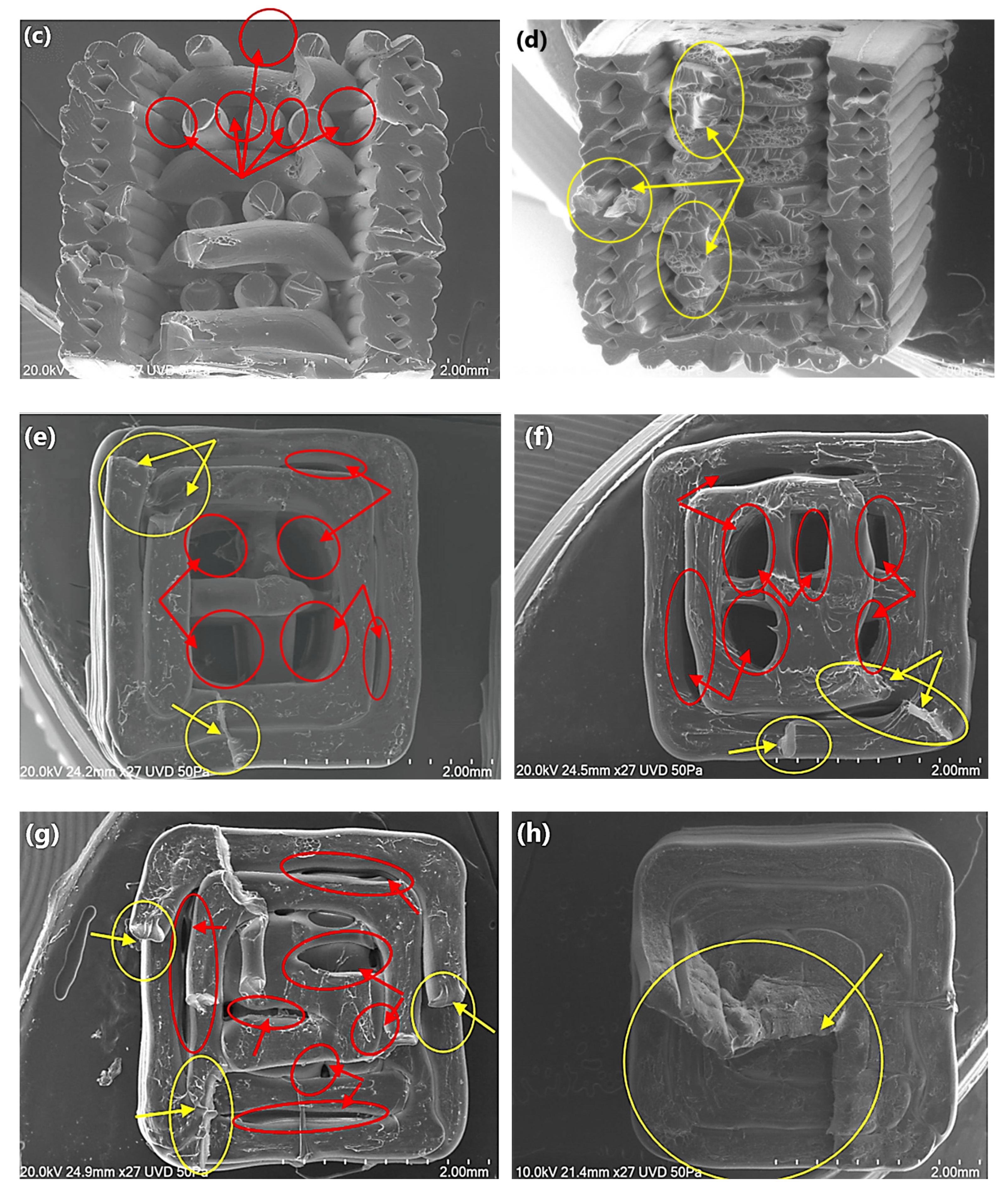


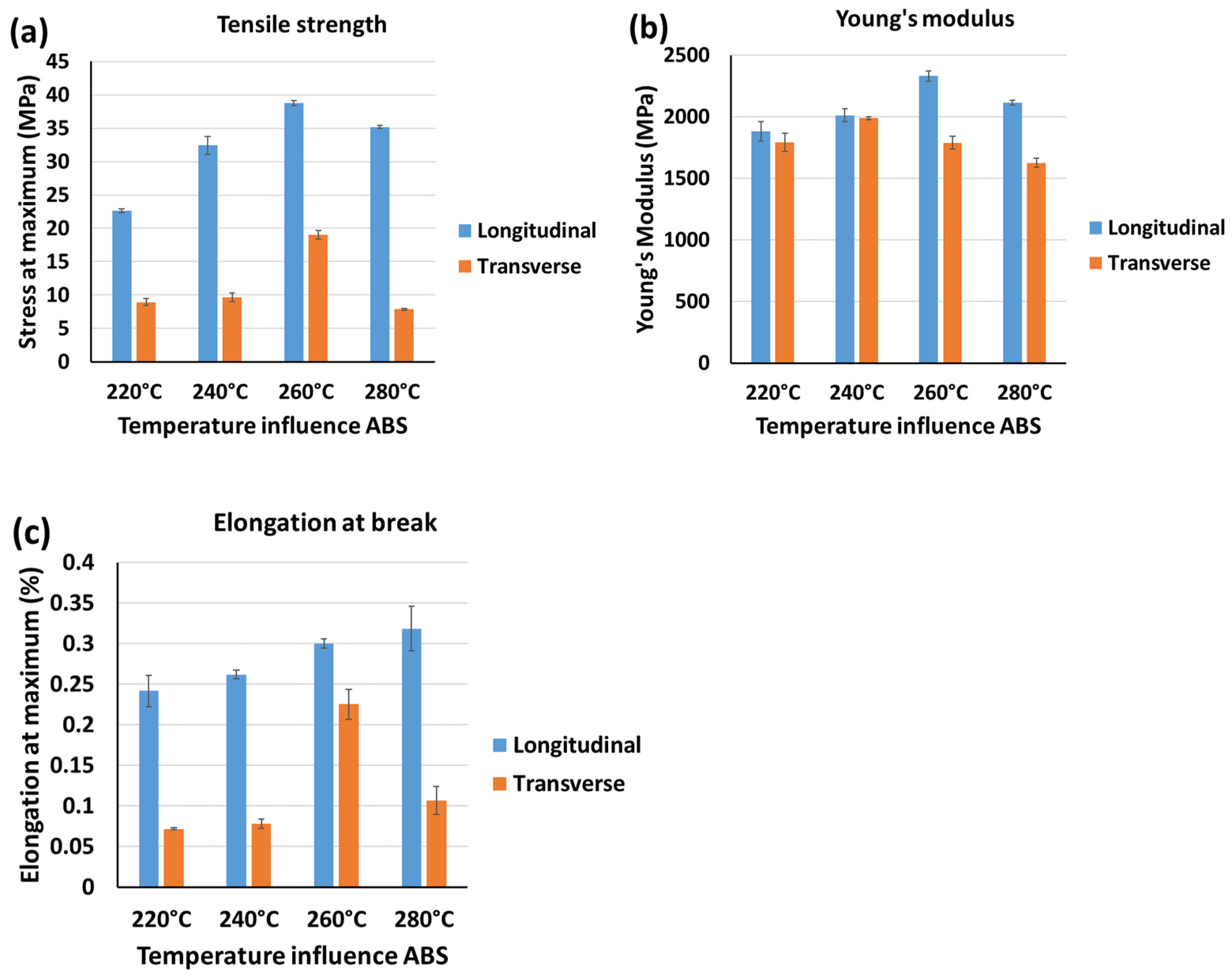
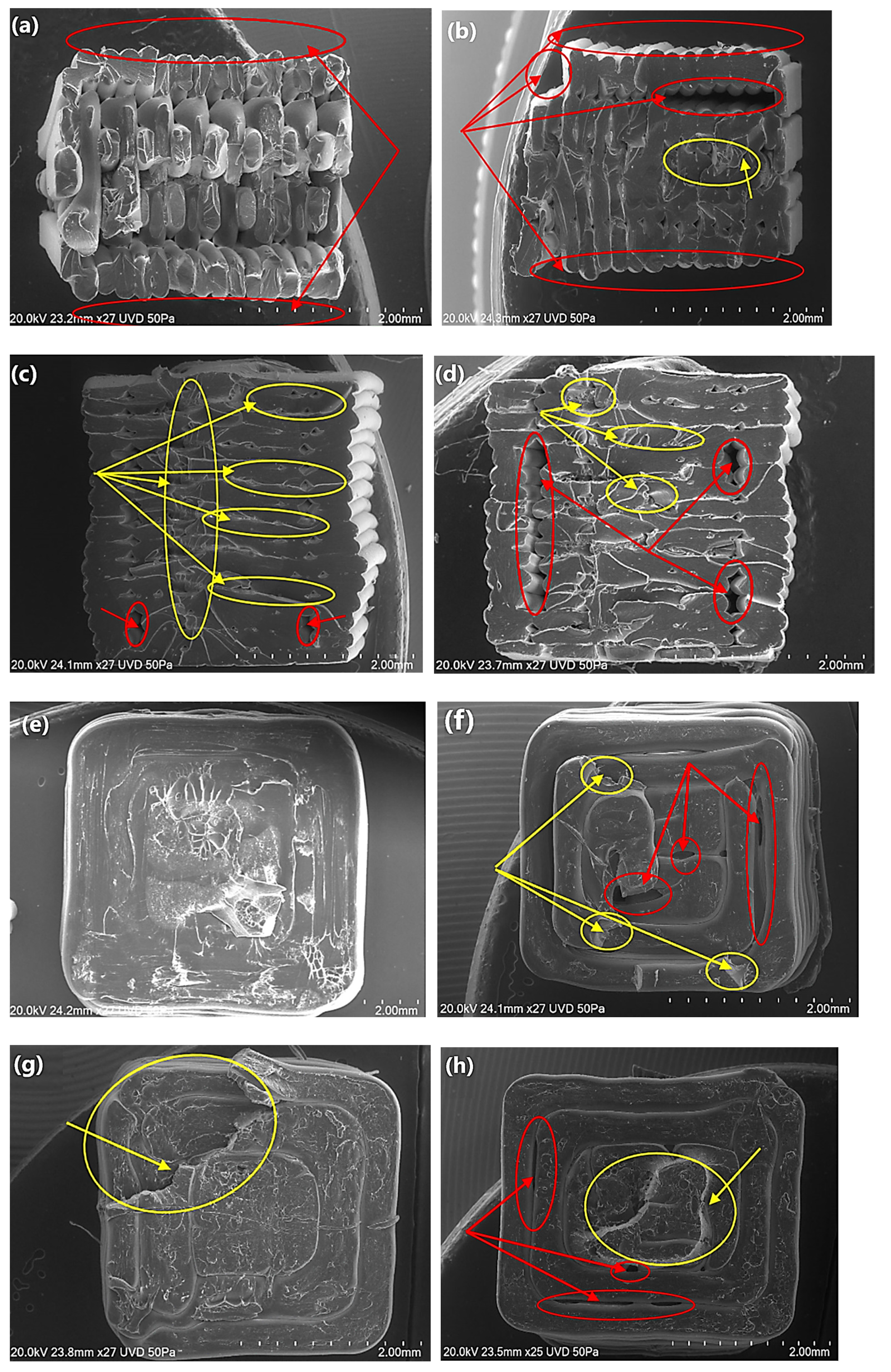

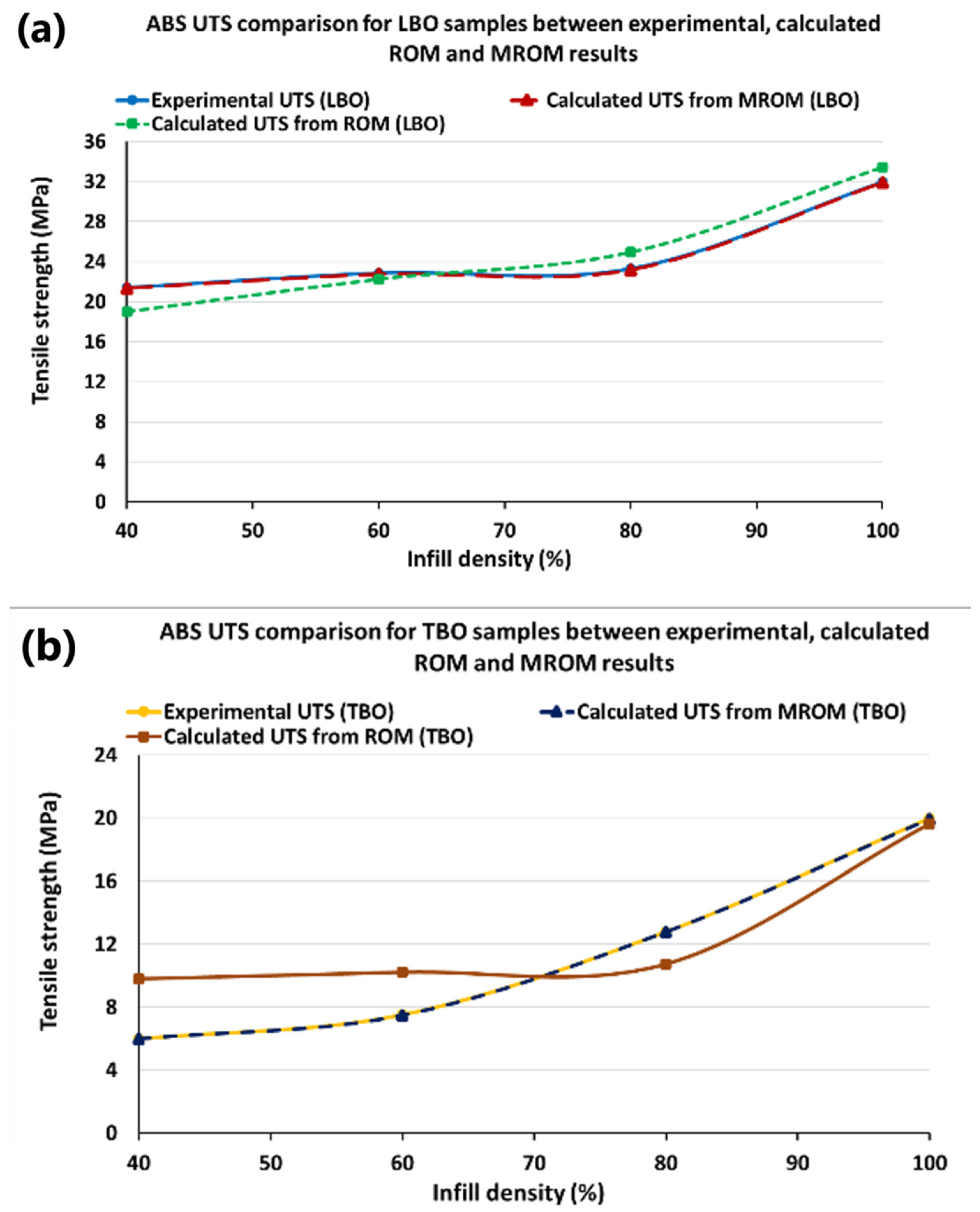
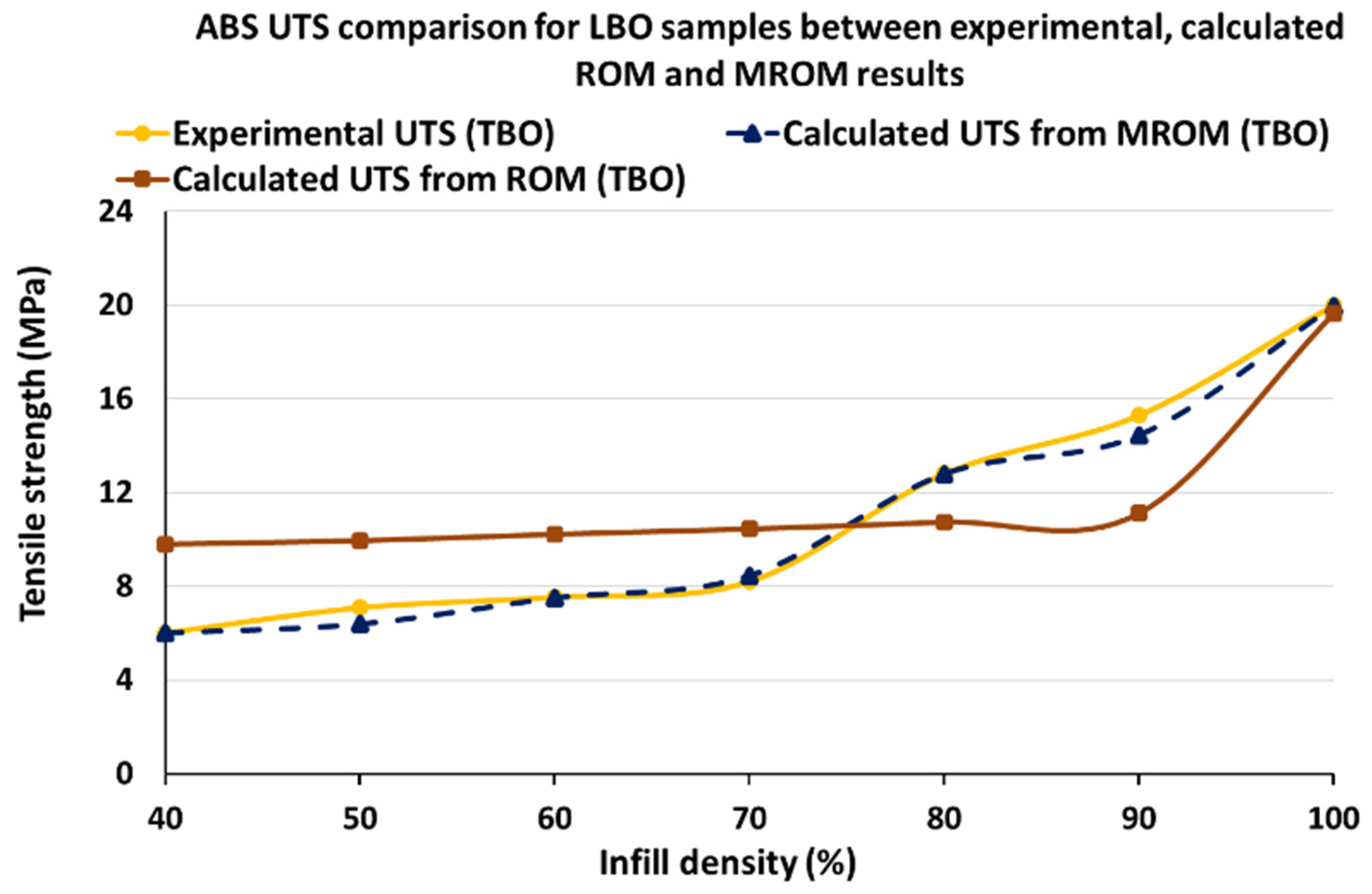
| Parameters | Values | |||
|---|---|---|---|---|
| Extruder bore diameter | 2.5 mm, blank | |||
| Temperature | Temperatures (°C) | Zone 1 | Zone 2 | Zone 3 |
| 230 | 240 | 240 | ||
| Extrusion speed | 9–12 rpm | |||
| Winding speed | 8–11 rpm | |||
| Extruded filament diameter | 1.75 mm (±0.08 mm) | |||
| Room temperature | 22 °C | |||
| Room humidity | <55% | |||
| Machine Factor | Value |
|---|---|
| Printing temperature (V) | 220 °C, 240 °C, 260 °C, and 280 °C |
| Bed temperature (C) | 110 °C |
| Raster angle (V) | ±45° and ±90° |
| Infill percentage (V) | 40%, 60%, 80%, and 100% |
| Fill pattern (C) | Rectilinear |
| Air gap (C) | 0 |
| Infill speed (C) | 70 mm/s |
| Layer thickness | 0.15 mm, 0.25 mm, 0.35 mm |
| Raster width (C) | 0.5 mm |
| Nozzle diameter (C) | 0.4 mm |
| Build orientation (V) | Longitudinal and transverse |
| Longitudinal Build Orientation | ||||||
| Layer thickness | UTS(mean) (MPa) | UTS(SQRT Error Mean) (MPa) | Δ(mean) (%) | Δ(SQRT Error Mean) (%) | E(mean) (MPa) | E(SQRT Error Mean) (MPa) |
| 0.15 mm | 28.34 | 1.13 | 0.40 | 0.029 | 1880 | 42.21 |
| 0.25 mm | 33.31 | 0.45 | 0.59 | 0.062 | 1732 | 189.43 |
| 0.35 mm | 31.11 | 0.19 | 0.51 | 0.519 | 1811 | 102.45 |
| Transverse Build Orientation | ||||||
| Layer thickness | UTS(mean) (MPa) | UTS(SQRT Error Mean) (MPa) | Δ(mean) (%) | Δ(SQRT Error Mean) (%) | E(mean) (MPa) | E(SQRT Error Mean) (MPa) |
| 0.15 mm | 17.12 | 0.49 | 0.16 | 0.02 | 1883 | 58.34 |
| 0.25 mm | 12.21 | 0.19 | 0.12 | 0.006 | 1645 | 77.61 |
| 0.35 mm | 14.28 | 0.36 | 0.15 | 0.016 | 1649 | 102.19 |
| Longitudinal Build Orientation | ||||||
| Raster angle | UTS(mean) (MPa) | UTS(SQRT Error Mean) (MPa) | Δ(mean) (%) | Δ(SQRT Error Mean) (%) | E(mean) (MPa) | E(SQRT Error Mean) (MPa) |
| 0°/90° | 32 | 0.71 | 0.23 | 0.002 | 2285 | 28.06 |
| +45/−45 | 25.36 | 0.27 | 0.32 | 0.046 | 1668 | 46.49 |
| Transverse Build Orientation | ||||||
| Raster angle | UTS(mean) (MPa) | UTS(SQRT Error Mean) (MPa) | Δ(mean) (%) | Δ(SQRT Error Mean) (%) | E(mean) (MPa) | E(SQRT Error Mean) (MPa) |
| 0°/90° | 19.03 | 0.61 | 0.22 | 0.018 | 1788 | 51.02 |
| +45/−45 | 10.65 | 0.43 | 0.09 | 0.005 | 1747 | 77.91 |
| Longitudinal Build Orientation | ||||||
| Infill percentages | UTS(mean) (MPa) | UTS(SQRT Error Mean) (MPa) | Δ(mean) (%) | Δ(SQRT Error Mean) (%) | E(mean) (MPa) | E(SQRT Error Mean) (MPa) |
| 40% | 21.41 | 0.35 | 0.45 | 0.023 | 1045 | 16.82 |
| 60% | 22.86 | 0.19 | 0.36 | 0.021 | 1266 | 11.33 |
| 80% | 23.27 | 0.47 | 0.28 | 0.006 | 1455 | 29.30 |
| 100% | 32 | 0.71 | 0.23 | 0.002 | 2285 | 28.06 |
| Transverse Build Orientation | ||||||
| Infill percentages | UTS(mean) (MPa) | UTS(SQRT Error Mean) (MPa) | Δ(mean) (%) | Δ(SQRT Error Mean) (%) | E(mean) (MPa) | E(SQRT Error Mean) (MPa) |
| 40% | 6 | 0.43 | 0.09 | 0.004 | 1144 | 60.37 |
| 60% | 7.5 | 0.40 | 0.11 | 0.005 | 1271 | 49.15 |
| 80% | 12.8 | 0.40 | 0.16 | 0.024 | 1512 | 48.07 |
| 100% | 20 | 0.61 | 0.22 | 0.018 | 1750 | 51.02 |
| Longitudinal Build Orientation | ||||||
| Nozzle temperature | UTS(mean) (MPa) | UTS(SQRT Error Mean) (MPa) | Δ(mean) (%) | Δ(SQRT Error Mean) (%) | E(mean) (MPa) | E(SQRT Error Mean) (MPa) |
| 220 °C | 22.6 | 0.27 | 0.24 | 0.019 | 1881 | 70.42 |
| 240 °C | 32.42 | 1.36 | 0.26 | 0.005 | 2012 | 43.01 |
| 260 °C | 38.75 | 0.34 | 0.30 | 0.005 | 2331 | 13.50 |
| 280 °C | 35.19 | 0.22 | 0.318 | 0.027 | 2113 | 90.92 |
| Transverse Build Orientation | ||||||
| Nozzle temperature | UTS(mean) (MPa) | UTS(SQRT Error Mean) (MPa) | Δ(mean) (%) | Δ(SQRT Error Mean) (%) | E(mean) (MPa) | E(SQRT Error Mean) (MPa) |
| 220 °C | 8.96 | 0.51 | 0.07 | 0.001 | 1793 | 74.95 |
| 240 °C | 9.66 | 0.62 | 0.08 | 0.005 | 1988 | 13.59 |
| 260 °C | 19.03 | 0.61 | 0.22 | 0.018 | 1788 | 51.02 |
| 280 °C | 7.85 | 0.13 | 0.10 | 0.017 | 1626 | 35.21 |
| Infill (%) | Experimental UTS (LBO) | Calculated UTS from ROM (LBO) | Calculated UTS from MROM (LBO) | Error (%) ROM | Error (%) MROM |
|---|---|---|---|---|---|
| 40 | 21.4 | 19.0 | 21.4 | 11.3 | 0.12 |
| 60 | 22.9 | 22.3 | 22.8 | 2.7 | 0.40 |
| 80 | 23.3 | 25.0 | 23.2 | 7.1 | 0.40 |
| 100 | 32.0 | 33.5 | 31.9 | 4.5 | 0.25 |
| Infill (%) | Experimental UTS (TBO) | Calculated UTS from ROM (TBO) | Calculated UTS from MROM (TBO) | Error (%) ROM | Error (%) MROM |
|---|---|---|---|---|---|
| 40 | 6.0 | 9.8 | 6.0 | 63.3 | 0.01 |
| 60 | 7.5 | 10.2 | 7.5 | 35.7 | 0.43 |
| 80 | 12.8 | 10.7 | 12.8 | 16.1 | 0.04 |
| 100 | 20.0 | 19.7 | 20.0 | 1.8 | 0.22 |
| Infill (%) | Experimental UTS (TBO) | Calculated UTS from ROM (TBO) | Calculated UTS from MROM (TBO) | Error (%) ROM | Error (%) MROM |
|---|---|---|---|---|---|
| 40 | 6.0 | 9.8 | 6.0 | 63.3 | 0.01 |
| 50 | 7.0 | 10.0 | 6.4 | 40.4 | 9.87 |
| 60 | 7.5 | 10.2 | 7.5 | 35.7 | 0.43 |
| 70 | 8.2 | 10.5 | 8.5 | 27.4 | 3.05 |
| 80 | 12.8 | 10.7 | 12.8 | 16.1 | 0.04 |
| 90 | 15.3 | 11.1 | 14.5 | 27.3 | 5.55 |
| 100 | 20.0 | 19.7 | 20.0 | 1.8 | 0.22 |
Disclaimer/Publisher’s Note: The statements, opinions and data contained in all publications are solely those of the individual author(s) and contributor(s) and not of MDPI and/or the editor(s). MDPI and/or the editor(s) disclaim responsibility for any injury to people or property resulting from any ideas, methods, instructions or products referred to in the content. |
© 2024 by the authors. Licensee MDPI, Basel, Switzerland. This article is an open access article distributed under the terms and conditions of the Creative Commons Attribution (CC BY) license (https://creativecommons.org/licenses/by/4.0/).
Share and Cite
Zohdi, N.; Nguyen, P.Q.K.; Yang, R. Evaluation on Material Anisotropy of Acrylonitrile Butadiene Styrene Printed via Fused Deposition Modelling. Appl. Sci. 2024, 14, 1870. https://doi.org/10.3390/app14051870
Zohdi N, Nguyen PQK, Yang R. Evaluation on Material Anisotropy of Acrylonitrile Butadiene Styrene Printed via Fused Deposition Modelling. Applied Sciences. 2024; 14(5):1870. https://doi.org/10.3390/app14051870
Chicago/Turabian StyleZohdi, Nima, Phan Quoc Khang Nguyen, and Richard (Chunhui) Yang. 2024. "Evaluation on Material Anisotropy of Acrylonitrile Butadiene Styrene Printed via Fused Deposition Modelling" Applied Sciences 14, no. 5: 1870. https://doi.org/10.3390/app14051870
APA StyleZohdi, N., Nguyen, P. Q. K., & Yang, R. (2024). Evaluation on Material Anisotropy of Acrylonitrile Butadiene Styrene Printed via Fused Deposition Modelling. Applied Sciences, 14(5), 1870. https://doi.org/10.3390/app14051870





_Yang.png)

